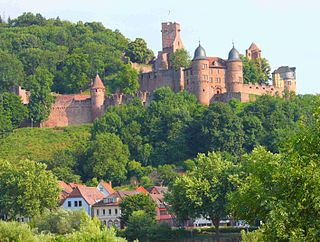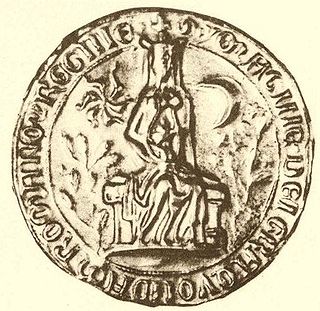John II of Isenburg-Limburg was Lord of Limburg an der Lahn and the last Count of Isenburg-Limburg from 1365 until 1406. He is sometimes designated John III to differentiate him from his non-ruling older half-brother John II (died before 1353). [1]

Limburg an der Lahn is the district seat of Limburg-Weilburg in Hesse, Germany.
The Countship of Isenburg-Limburg was a state of the Holy Roman Empire in the 13th and 14th centuries, based around the city of Limburg an der Lahn in modern Hesse, Germany.
Contents
He was the third son of Count Gerlach V of Isenburg-Limburg from his second marriage (fourth altogether). His mother was Kunigunde of Wertheim. His eldest brother, Gerlach VI of Isenburg-Limburg, had died in the Black Death without male heirs in 1365, and his next oldest brother Hermann had died the same year. With the permission of Pope Urban V, John put aside the office of Canon of Trier Cathedral and took over the rule of Limburg as John II.
Gerlach V of Isenburg-Limburg, also called Gerlach II "the Elder" of Limburg, was Count of Isenburg-Limburg. He reigned between 1312 and 1355 as Lord of Limburg an der Lahn, and the head of the House of Limburg. The chronicler Tilemann Elhen von Wolfhagen describes him, in his pre-1402 Limburger Chronicle, as a virtuous nobleman and a bright poet in German and Latin.

Wertheim is a town in southwestern Germany, in the state of Baden-Württemberg with a population of around 23,400. It is located on the confluence of the rivers Tauber and Main. Wertheim is best known for its landmark castle and medieval town centre.
Gerlach VI of Isenburg-Limburg, also known as Gerlach III of Limburg, was Count of Isenburg-Limburg and Lord of Limburg an der Lahn. He succeeded his father Gerlach V in 1355. In 1356, he married Elisabeth of Falkenstein.
Gerlach V had pledged the Lordship of Limburg an der Lahn to the Archbishopric of Trier between 1344 and 1346. In 1374 Limburg’s imperial sovereignty also fell to Trier. [2]
After John's death without heirs in 1406, the House of Isenburg-Limburg was extinct. Limburg was then annexed by Trier. The Archbishop at the time was Werner of Falkenstein.





